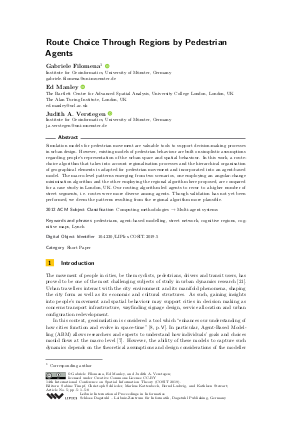Route Choice Through Regions by Pedestrian Agents (Short Paper)
Authors
Gabriele Filomena  ,
Ed Manley
,
Ed Manley  ,
Judith A. Verstegen
,
Judith A. Verstegen 
-
Part of:
Volume:
14th International Conference on Spatial Information Theory (COSIT 2019)
Part of: Series: Leibniz International Proceedings in Informatics (LIPIcs)
Part of: Conference: Conference on Spatial Information Theory (COSIT) - License:
 Creative Commons Attribution 3.0 Unported license
Creative Commons Attribution 3.0 Unported license
- Publication Date: 2019-09-03
File

PDF
LIPIcs.COSIT.2019.5.pdf
- Filesize: 11.18 MB
- 8 pages
Document Identifiers
Subject Classification
ACM Subject Classification
- Computing methodologies → Multi-agent systems
Keywords
- pedestrians
- agent-based modelling
- street network
- cognitive regions
- cognitive maps
- Lynch
Metrics
- Access Statistics
-
Total Accesses (updated on a weekly basis)
0PDF Downloads0Metadata Views
Abstract
Simulation models for pedestrian movement are valuable tools to support decision-making processes in urban design. However, existing models of pedestrian behaviour are built on simplistic assumptions regarding people’s representation of the urban space and spatial behaviour. In this work, a route-choice algorithm that takes into account regionalisation processes and the hierarchical organisation of geographical elements is adapted for pedestrian movement and incorporated into an agent-based model. The macro-level patterns emerging from two scenarios, one employing an angular-change minimisation algorithm and the other employing the regional algorithm here proposed, are compared for a case study in London, UK. Our routing algorithm led agents to recur to a higher number of street segments, i.e. routes were more diverse among agents. Though validation has not yet been performed, we deem the patterns resulting from the regional algorithm more plausible.
Cite As Get BibTex
Gabriele Filomena, Ed Manley, and Judith A. Verstegen. Route Choice Through Regions by Pedestrian Agents (Short Paper). In 14th International Conference on Spatial Information Theory (COSIT 2019). Leibniz International Proceedings in Informatics (LIPIcs), Volume 142, pp. 5:1-5:8, Schloss Dagstuhl – Leibniz-Zentrum für Informatik (2019)
https://doi.org/10.4230/LIPIcs.COSIT.2019.5
BibTex
@InProceedings{filomena_et_al:LIPIcs.COSIT.2019.5,
author = {Filomena, Gabriele and Manley, Ed and Verstegen, Judith A.},
title = {{Route Choice Through Regions by Pedestrian Agents}},
booktitle = {14th International Conference on Spatial Information Theory (COSIT 2019)},
pages = {5:1--5:8},
series = {Leibniz International Proceedings in Informatics (LIPIcs)},
ISBN = {978-3-95977-115-3},
ISSN = {1868-8969},
year = {2019},
volume = {142},
editor = {Timpf, Sabine and Schlieder, Christoph and Kattenbeck, Markus and Ludwig, Bernd and Stewart, Kathleen},
publisher = {Schloss Dagstuhl -- Leibniz-Zentrum f{\"u}r Informatik},
address = {Dagstuhl, Germany},
URL = {https://drops.dagstuhl.de/entities/document/10.4230/LIPIcs.COSIT.2019.5},
URN = {urn:nbn:de:0030-drops-110971},
doi = {10.4230/LIPIcs.COSIT.2019.5},
annote = {Keywords: pedestrians, agent-based modelling, street network, cognitive regions, cognitive maps, Lynch}
}
Author Details
- The Bartlett Centre for Advanced Spatial Analysis, University College London, London, UK
- The Alan Turing Institute, London, UK
References
-
Gustavo Kuhn Andriotti and Franziska Klügl. Agent-Based Simulation Versus Econometrics – from Macro- to Microscopic Approaches in Route Choice Simulation. In K. Fischer, I.J. Timm, E. André, and N. Zhong, editors, Multiagent System Technologies. MATES 2006. Lecture Notes in Computer Science, vol 4196, pages 61-72. Springer, Berlin, Heidelberg, 2006.

- Vincent D. Blondel, Jean-Loup Guillaume, Renaud Lambiotte, and Etienne Lefebvre. Fast unfolding of communities in large networks. Journal of Statistical Mechanics: Theory and Experiment, 2008(10):1-12, October 2008. URL: https://doi.org/10.1088/1742-5468/2008/10/P10008.
- Stefano Boccaletti, Ginestra Bianconi, Regino Criado, C. I. del Genio, Jesus Gómez-Gardeñes, Miguel Romance, Irene Sendiña-Nadal, Z. Wang, and M. Zanin. The structure and dynamics of multilayer networks. Physics Reports, 544(1):1-122, 2014. URL: https://doi.org/10.1016/j.physrep.2014.07.001.
- David Caduff and Sabine Timpf. On the assessment of landmark salience for human navigation. Cognitive Processing, 9(4):249-267, November 2008. URL: https://doi.org/10.1007/s10339-007-0199-2.
- Paolo Crucitti, Vito Latora, and Sergio Porta. Centrality in networks of urban streets. Chaos: An Interdisciplinary Journal of Nonlinear Science, 16(015113):1-9, 2006. URL: https://doi.org/10.1063/1.2150162.
- Gabriele Filomena, Judith A. Verstegen, and Ed Manley. A computational approach to ‘The Image of the City’. Cities, 89:14-25, 2019. URL: https://doi.org/10.1016/J.CITIES.2019.01.006.
-
Carlos Gershenson. Self-Organizing Urban Transportation Systems. In Juval Portugali, Han Meyer, Egbert Stolk, and Ekim Tan, editors, Complexity Theories of Cities Have Come of Age, pages 269-279. Springer, Heidelberg, 2012.

- Marco Helbich, Jamal Jokar Arsanjani, and Michael Leitner, editors. Computational Approaches for Urban Environments. Springer, Cham, Heidelberg, 2015. URL: https://doi.org/10.1007/978-3-319-11469-9.
-
Bill Hillier and Julienne Hanson. The social logic of space. Cambridge University Press, Cambridge, UK, 1984.

- Bin Jiang and Tao Jia. Agent-based simulation of human movement shaped by the underlying street structure. International Journal of Geographical Information Science, 25(1):51-64, 2011. URL: https://doi.org/10.1080/13658811003712864.
-
Kevin Lynch. The image of the city. MIT Press, Cambridge, MA, 1960.

- Ed Manley, Tao Cheng, Alan Penn, and Andy Emmonds. A framework for simulating large-scale complex urban traffic dynamics through hybrid agent-based modelling. Computers, Environment and Urban Systems, 44:27-36, 2014. URL: https://doi.org/10.1016/j.compenvurbsys.2013.11.003.
- Ed Manley, Shepley W. Orr, and Tao Cheng. A heuristic model of bounded route choice in urban areas. Transportation Research Part C: Emerging Technologies, 56:195-209, 2015. URL: https://doi.org/10.1016/j.trc.2015.03.020.
- Timothy P. McNamara, James K. Hardy, and Stephen C. Hirtle. Subjective hierarchies in spatial memory. Journal of Experimental Psychology: Learning, Memory, and Cognition, 15(2):211-227, 1989. URL: https://doi.org/10.1037/0278-7393.15.2.211.
- Itzhak Omer and Nir Kaplan. Using space syntax and agent-based approaches for modeling pedestrian volume at the urban scale. Computers, Environment and Urban Systems, 64:57-67, July 2017. URL: https://doi.org/10.1016/J.COMPENVURBSYS.2017.01.007.
-
Alan Penn and Alasdair Turner. Space Syntax Based Agent Simulation. In 1st International Conference on Pedestrian and Evacuation Dynamics, Duisburg, 2001.

- Greg Rybarczyk. Simulating bicycle wayfinding mechanisms in an urban environment. Urban, Planning and Transport Research, 2(1):89-104, 2014. URL: https://doi.org/10.1080/21650020.2014.906909.
- Edward K. Sadalla and Daniel R. Montello. Remembering changes in direction. Environment and Behavior, 21(3):346-363, 1989. URL: https://doi.org/10.1177/0013916589213006.
- Emanuele Strano, Saray Shai, Simon Dobson, and Marc Barthelemy. Multiplex networks in metropolitan areas: Generic features and local effects. Journal of the Royal Society Interface, 12(111):1-12, 2015. URL: https://doi.org/10.1098/rsif.2015.0651.
- Holly A. Taylor and Barbara Tversky. Spatial mental models derived from survey and route descriptions. Journal of Memory and Language, 31(2):261-292, 1992. URL: https://doi.org/10.1016/0749-596X(92)90014-O.
- Paul M. Torrens. Computational Streetscapes. Computation, 4(37):1-38, 2016. URL: https://doi.org/10.3390/computation4030037.
